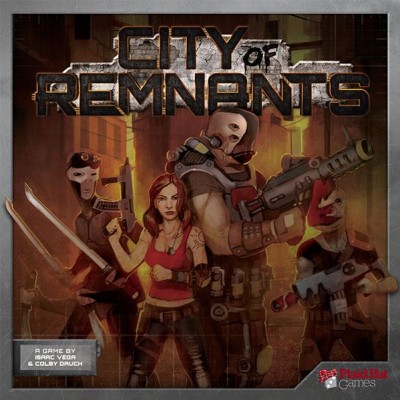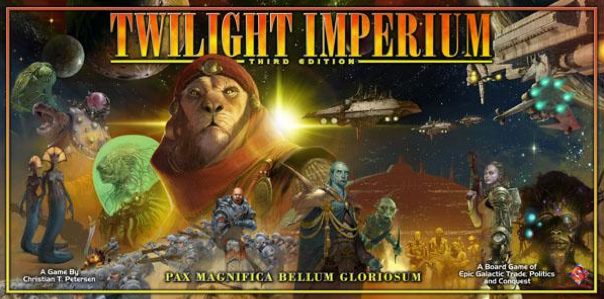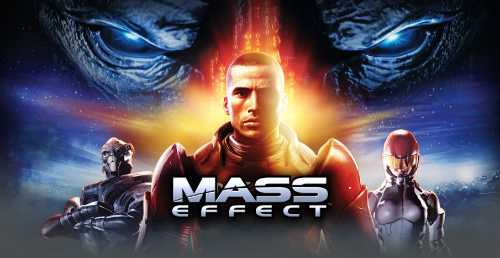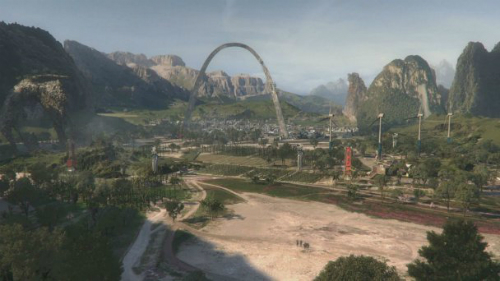Part Five: Unrealized Possibilities
Up until this point, my various segments on science fiction RPGs have examined what separates them from fantasy games, what games that met little to no success, the challenges that a sci-fi roleplaying game must overcome to be successful, and, in my opinion, what the current market contender is for a great science fiction game. In this, my final installment of this series, we will peruse other promising science fiction intellectual properties that yet to have a roleplaying game. There are several science fiction settings in the greater gaming world which hold a solid fan base, but do not currently have an accompanying RPG. Ranging from fairly simple to extremely complex, these settings are teeming with ideas that provide wide appeal to gamers. It’s surprising that none of these have one already. With a proper treatment and exploration, these setting can come to life with ease, and they would introduce new aspects to the overall science fiction gaming experience.
Android
 One of the most glaring examples is the Android setting created by Fantasy Flight Games. Created originally as part of the Android board game, it features two futuristic cities peopled by familiar characters with familiar problems.
One of the most glaring examples is the Android setting created by Fantasy Flight Games. Created originally as part of the Android board game, it features two futuristic cities peopled by familiar characters with familiar problems.
The Earthside city New Angeles sits at the base of a massive space elevator called the Beanstalk, with the Moonside colony of Heinlein glittering in the night above it. On the streets of New Angeles and Heinlein, a murder had been committed. Several investigators try to solve it while grappling with their own issues – and uncovering a vast conspiracy.
Android creates a compelling neo-noir world set significantly into the future. It features artificial bio-roids, work-a-day cyborgs, psychic clones, flying personal cars, and, of course, shadowy megacorps. The world is further explored by the additional games Infiltration and Netrunner, and Android’s cyberpunk setting even features a novel line to further flesh it out.
Originally inspired by Cyberpunk 2020, Android’s setting has moved past the older game, which was strongly beginning to show its age. Science fiction must always strive to be updated, as technology is always marching forwards. What Android captures is the knowledge that even with the world advancing at a breakneck pace, the old problems of humanity remain. When people are poor, bigoted, and angry, that will lead to violence. Crimes of passion still happen, and you can never trust the system.
Infiltration expanded on this conflict by looking deeper into corporate espionage and struggle and Netrunner fully embracing the hacker culture of the little guy against the corporate giant. An RPG set in the world of Android would be able to support several game models, from the corporate troubleshooter team to the police procedural investigation to the sweeping urban epic. It is a large world that is at once familiar and new. A proper treatment of Android as a skill based, dynamic action game would be able to establish itself powerfully into the RPG market, with a principal focus on cinematic resolution and flawed characters.
City of Remnants
 Another board game property rife with roleplaying potential is City of Remnants by Plaid Hat Games. In City of Remnants, several races have been conquered by the imperial Yugai and forcibly removed from their homes. These refugees wind up on the world Gatorum, which is equal parts prison and work camp.
Another board game property rife with roleplaying potential is City of Remnants by Plaid Hat Games. In City of Remnants, several races have been conquered by the imperial Yugai and forcibly removed from their homes. These refugees wind up on the world Gatorum, which is equal parts prison and work camp.
On Gatorum, humans rub elbows with various alien races in cramped, run down ghettos. Gangs battle each other endlessly for dominance, scrapping out block-by-block for control of any precious resource they can build or scavenge. The Yugai themselves oversee the planet, regularly dispatching patrols to provide food and supplies to the residents of Gatorum – and to punish them for the violation of the numerous laws (or general civil disobedience). Life is dirty, desperate and cheap on Gatorum, and it takes strength and wits to get ahead. Casual acceptance of brutality helps too.
The City of Remnants board game is a visually appealing and mechanically immersive game. The five races presented are distinct and iconic, with each being similar enough to humanity to be compelling, but different enough to truly stand apart. The artwork presents scenes of action and danger, and the mechanics provide an amazing sense of just how oppressive life under the Yugai rule truly is. City of Remnants feels like being shoved in an overcrowded jail cell peopled with opposing gang members. As a roleplaying game, players could move beyond the block by block grind of gang warfare and into more distinct stories. There is no sense in the game how long the Yugai have been conquering, but Gatorum feels at once both modern and run down. Players could explore the world, make alliances, and struggle to survive despite the odds against them.
A City of Remnants RPG would need a very good combat system, however, with strong elements for both strategy and luck. Scarcity of resources would be a fundamental factor, and every injury would need to hurt. A well-balanced salvage and jury-rigging system would also be a strength of this game. With its aesthetic of a cosmopolitan refugee camp amidst ruins and a compelling narrative of broken people trying to survive, City of Remnants would be able to offer narratives other games simply cannot.
Twilight Imperium

Another Fantasy Flight game, Twilight Imperium, has gone through three editions as a board game, along with an ancillary card game and a secondary board game. The world illustrated in Twilight Imperium’s cards, events, artwork, and descriptions is a post-collapse galactic empire, where many space-faring species are beginning to rediscover each other. Once united under the Lazax empire from the mighty Mecatol Rex, the collapse of the empire gave rise to xenophobia and species-based feudalism carving up the known systems. Now, though, these races are looking to expand once again. Each species competes with each other, seeking power through economic, political, and military means. The prize at the end is the reunification of the galaxy under a new galactic empire, with one’s own species standing in the place of the destroyed Lazax civilization.
Since its original release in 1998, TI’s world has steadily expanded to include more species, more planets, and more strange technologies and events. The species of Twilight Imperium include many standard science-fiction aliens, with the short-lived, cosmopolitan humans rubbing shoulders with giant leonine Hacan, insectile Sardakk N’orr, and the light-hating Letnev to name a few. Each species has their own distinct feel to them, with the snapping turtle politicians of the Xxcha standing even with the ruthless pirates of the Mentak Coalition. Furthermore, the state of the universe is one filled with ancient threats, desperate people, and strange prophecies that feels similar to Dune. Much of this exposition was shown in the more flavor text heavy Second Edition, but the current Third Edition retains much of the same flavor.
In the ruins of a titanic galactic empire, these prophecies and power shifts could easily give rise to a very successful RPG. Such a game could focus on the truly diverse universe of Twilight Imperium, not only with an expansive setting, but also the means to create wholly new worlds and systems. Player characters could be spies, explorers, soldiers, or merchants simply trying to get ahead. Twilight Imperium as a roleplaying game setting could be a truly fantastic “Have Spaceship, Will Travel” style of game.
Mass Effect
Board games are hardly the only source material for science fiction RPGs. Science fiction is enjoying a renewal of interest in both television and video games, with several notable franchises placed perfectly for adaption. From video games comes the world of Bioware’s Mass Effect, providing a backdrop of high action space opera and a unique approach towards humanity’s role in the cosmos. In the world of Mass Effect, ancient alien technologies allow for the manipulation of gravity and mass. With this technology, several powerful races have joined together in a galactic government based around the discovered space station, the Citadel. Humanity is new on the scene to the galactic government and holds a tenuous position at best, viewed mostly as young, foolish, and dangerous. Still, Earth and its colonies are determined to carve their own destiny from the heart of the galaxy, and this ambition leads them into direct conflict with a terrible and powerful force biding its time for a galactic harvest.
 Mass Effect takes a great deal of effort in maintaining a sci-fi atmosphere, despite the inclusion of extremely advanced technologies and a softer approach towards certain sciences. One of the main themes of Mass Effect is the cycle of conflict between biological and artificial intelligence, and it uses both sides to show worlds in various states of order or chaos.
Mass Effect takes a great deal of effort in maintaining a sci-fi atmosphere, despite the inclusion of extremely advanced technologies and a softer approach towards certain sciences. One of the main themes of Mass Effect is the cycle of conflict between biological and artificial intelligence, and it uses both sides to show worlds in various states of order or chaos.
The species of Mass Effect’s galaxy go beyond the humanoid mold, featuring telepathic plants, uplifted jellyfish, and various forms of artificial entities. Even its use of “biotics” is based in a softer science approach, with the strange powers being forms of psychic gravity manipulation rooted in exposure to the titular mass effect, and enhanced through applied technology.
The video games provide a model of character classes with specialization during level based advancement, as well as several species for players to embrace. Similar to Legend of the Five Rings’ most recent edition, Mass Effect would best be done as a timeline neutral game with an open and detailed world, allowing Game Masters and players to explore the intrigue and mystery-filled settings however they see fit, without being tied to the narrative of the games themselves.
Defiance
 Bridging the gap between television show and video game, one of Syfy Channel’s latest ventures could serve as an excellent roleplaying game. Defiance takes place on an Earth in the not too distant future, where a large population of alien refugees arrived, having fled the destruction of their home system. Peaceful settlement of their population on Earth fell apart, leading to a massive war which left all sides reeling and the Earth vastly transformed.
Bridging the gap between television show and video game, one of Syfy Channel’s latest ventures could serve as an excellent roleplaying game. Defiance takes place on an Earth in the not too distant future, where a large population of alien refugees arrived, having fled the destruction of their home system. Peaceful settlement of their population on Earth fell apart, leading to a massive war which left all sides reeling and the Earth vastly transformed.
Eventually, a peace accord was struck for sheer survival of all parties, and both the humans and the Votan alien species had to learn how to live together in a dangerous and hostile world. The television series is set in the town of Defiance, on the ruins of old St. Louis, Missouri, while the video game focuses on the Bay Area near the ruins of San Francisco. Both humans and the various Votan species struggle for survival against raiders, dangerous fauna, and not entirely benevolent governments. Both the game and the television series possess a wild west feel, mixed heavily with imaginative takes on aliens.
As with Mass Effect, the video game can be used as an existing framework to an RPG set in the world of Defiance. In the video game, players control “ark hunters” who search for the falling ruined Votan spaceships to acquire salvage. This salvage can be used to advance the sciences, acquire better weapons, or simply score some extra cash. While the video game presents ark hunters who have been artificially enhanced for the purposes of the game’s massive multiplayer narrative, a tabletop RPG would do well using the television series instead as a model for its ideal power level. The TV show would also offer an alternative model of game, focusing on a group of survivors trying to build a community on a frontier and prosper. For a roleplaying game to effectively do both, there would need a classless progression with open choices for skills and species. Each species would need to feel distinct, with defining traits being provided as guidelines rather than handcuffs. Of all the games mentioned thus far, Defiance would be best served by an adaptation to the FATE Core system.
Tech-savvy Superheroes
 The other main development from television that could function as a roleplaying game would not come from a single show, but several. In recent years, TV and film have begun to redefine the superhero genre, bringing it in line with a more science fiction ethos.
The other main development from television that could function as a roleplaying game would not come from a single show, but several. In recent years, TV and film have begun to redefine the superhero genre, bringing it in line with a more science fiction ethos.
Films like Batman Begins, television series such as Arrow or Agents of SHIELD, and much of what Marvel Studios has done in the last decade have brought the superhero to street level – but with the aid of superior technology. Shows such as Alphas and Persons of Interest examine a world similar to our own, where a superior facet to some people exist.
These stories present a world that is almost parallel to ours, save with access to some easily understood element that make them better. Batman has access to extreme resources, but he and his enemies are not truly superhuman. The Machine can predict crimes before they happen, allowing the heroes to prevent them. The Alphas (a sort of mutant-less X-Men) each have something that makes them better than the baseline human, but the world is not one where that is celebrated.
While many of these settings is not widely viewed as science fiction in the classic sense, each of them tap into a zeitgeist of how fast the world is advancing technologically. Each of these stories feature superheroes, but these heroes do not crow their achievements from the rooftops. They are conflicted vigilantes using questionable methods to achieve what they hope to be noble goals.
An RPG that embraced this new love of street level science fiction would be both topical and successful. It would live and die by its adaptability, allowing for characters to be either specially powered or specially equipped. The game would need to know the limits of its narratives and be strong enough to hold the characters in place, while being large enough to give them room to grow. Such a roleplaying game would follow in the footsteps of Spycraft and Leverage, giving a slightly darker, slightly more advanced version on the modern world, where justice hides its face and adventure comes at a high price.
The market for roleplaying games is caught currently in a moment between major releases. Dungeons & Dragons, truly the giant in the playground, stands between editions. Meanwhile, Kickstarter has created an entirely new style of independently funded roleplaying games. Other games like Eclipse Phase have embraced the future of Creative Commons and digital distribution to put their games in the hands of the consumers and allowing them to choose how to much to pay for it. The face of RPGs is changing, and there is plenty of room for the next game. With all our current worldly concerns, there is no reason that it cannot be a science fiction one. Whether that comes from a wholly new creative endeavor, or from one of the intellectual properties already out there, the development of a new science fiction RPG could easily dominate the market in this tenable moment. And that would be an excellent thing.
David Gordon is a regular contributor to the site. A storyteller by trade and avowed tabletop veteran, he can be reached at dave@cardboardrepublic.com.
Photo Credits: Defiance by Syfy; Green Arrow by The CW.
